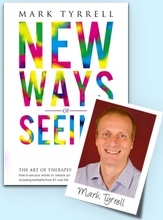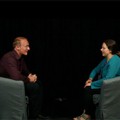
Techniques from solution focused therapy can help coaches keep clients moving
“What’s the difference between coaching and therapy?” I’ve written about this topic before, but now my new therapy client was actually asking me face to face.
Charles wanted my help to quit smoking. But he was keen to chat before we got to work kicking his ashtray habit into Never Never Land. So we chewed the fat for a bit.
“Three years ago”, he began mistily – already I could tell what he was about to say went deep – “I saw a life coach. She was the best thing that ever happened to me.”
A grateful tear formed at the corner of his eye. “Well, other than my wife… you understand.”
Prefer to watch instead?
Charles described how he had gone to this particular life coach on recommendation because he wanted more direction in his business life. But as it turned out, that was the least of his worries.
“I was in a bad way, still traumatized by the death of my daughter in a road accident three years before. I was depressed and anxious and angry… and that’s what was stopping me from even thinking about my business. To help me with my career goals, my coach also had to help me emotionally… if that makes sense.” I nodded.
“The way she helped me was so sensitive and effective. I started sleeping better and was no longer traumatized. I told her she was better than any therapy!”
So what had this coach done?
It sounded like Charles’s life coach had also been a solution-focused therapist. Or perhaps she had simply augmented her coaching skills with more psychologically therapeutic ones, or had qualified with a great coaching institute.
Charles hadn’t expected anything more than for his coach to be able to help him construct clearer business goals. The way she was able to help him move on from traumatic memories and feel hope for his future again was, he said, “a godsend”. She did more for him than he could ever have imagined.
In fact, he would have returned to her for help with his tobacco compulsion, but she’d since moved to Canada.
More recently a life coach pal asked me to teach him some techniques he could use to help his clients at least begin to overcome emotional blocks. Here’s three that I suggested to him. This is not necessarily ‘therapy’, but it can be really therapeutic and, for some, it can make all the difference.
Technique 1: Be a miracle maker
How? By asking the miracle question. Basically the miracle question is a goal-setting question that simply focuses on the client’s desired result, regardless of whether the client feels that it is ‘realistic’ or ‘achievable’ at this point. Many coaches already use a variation of this.
We encourage people to engage their creative selves, forget the hows and whens, and really focus on what they want. We can always work backwards to get the actual steps to that ‘miracle’.
So we might phrase the miracle question like this:
“If I wave a magic wand and tonight as you sleep a miracle occurs, tell me in detail how your life will be tomorrow. What will you notice, and what will other people notice? How will your day be after the miracle takes place?”
Now, if someone has lost a limb they might say: “I would never have lost my leg!” or “I never would have gotten sick.” So we’d need to make it clear that the ‘miracle’ needs to be connected to the way they feel about a problem, and start to transcend it.
The miracle question is a way of looking around the problem and is great for clients who only see the problem and don’t yet have a sense of life beyond it.
So often we ask our clients what they would like to have in their life or what they want from therapy. And so often the response goes something like: “I don’t want to be depressed” or “I don’t want to feel scared to pursue my goals.” The miracle question helps form goals in the positive.
You can read about and watch a quick video of me applying it here. And still more videos of me using the miracle question with real clients are available inside Uncommon Practitioners TV.
The next technique, or array of techniques, is really important and certainly made all the difference to Charles.
Technique 2: Don’t let the past stand in the way of the future
We are all the sum of our pasts. The unconscious mind builds up associations through experience, which have evolved to help us – as when we learn that a hot stove is… err… hot, and we avoid placing bare hands on said stove in future.
But sometimes our learned associations can be maladaptive in a modern world – as when the unconscious mind produces a flashback to a bomb explosion even though it’s just a firework this time.
Psychotherapists call this a ‘faulty pattern match’. And it’s useful to see if your client has any faulty pattern matches, forged in their past, as blocks to their progress. You can hear me talking in more detail about how the brain pattern matches here.
So how do you help your client break free of negative past conditioning so they can move forward?
First off I want to say that if your client is suffering full-blown flashbacks or a debilitating phobia, this may need to be lifted before further coaching can take place.
Charles was lucky enough to go to a coach who, along with an increasing number of life coaches, knew how to use an ethical and comfortable method of lifting trauma.
If you haven’t been coached in how to use a technique like Rewind, then refer the client to a therapist or other coach who is effective in quickly helping to lift this kind of life-blocking trauma or phobia. There are plenty out there.
But there are other ways to help ease less severe painful memories, such as the context-widening technique. This can have amazing results.
Take the focus away from the feelings
According to a study published in Social Cognitive and Affective Neuroscience (Denkova et al.,2014), if someone has a subthreshold trauma, a memory that is painful to recall but doesn’t produce flashbacks or nightmares, then you can help them feel better about that memory by having them think about it in a new way.
First, ask them to imagine seeing the memory from the outside (if you are skilled in relaxing your clients all the better, as they can do this with their eyes closed). Then ask them to focus not on the feelings they had in that time but the wider context.
So if someone got humiliatingly yelled at by a boss in a meeting in their previous job and that memory is stopping them from confidently speaking in their new job, you could ask them about the incidental context of the day:
- How many people were there?
- What was the weather like?
- What was the decor like in the room?
- What were people wearing?
And so forth. Doing this seems to retag the memory as much less threatening and can have amazing effects. You could even have the client write down as much of this incidental context as they remember, as writing painful memories down can also help soothe the pain and retag the memory in the brain as safe and in the past (1).
On the Uncommon Knowledge blog you can find a couple of other quick ways to help clients feel better about their pasts so they can really start to move on.
Before dealing with the present, Charles’ life coach delved into the past to help him overcome the horror of his flashbacks to when he first heard of his daughter’s fatal accident. With the traumatic feelings gone, Charles could finally engage in other aspects of the coaching process – such as working on his business, the reason he’d approached his coach in the first place.
Technique 3: Find the exception, find the solution
If a client has an emotional block then we can seek to find exception times – times when the block was, often unexpectedly, lifted. Great questions to ask are:
- “When didn’t it happen when you would have expected it to?”
- “What was different about that time?”
We have so much to learn from the exception times. When your client tells you what was different about that exception time, they may be giving you important clues as to how you can help them overcome the emotional problem.
For example, if someone tells you they just can’t seem to get started on a project, you might ask:
- When have you felt irresistibly drawn to doing something? (This could be a work piece, a personal project, even a hobby)
- Have you ever felt like you just had to watch the rest of the movie? Or you just had to read the rest of the book?
- Have you ever noticed time seem to vanish as you became deeply engaged in something?
Helping your client recapture that feeling and linking it to a current project is really powerful. If they tell you they feel like a failure, after listening and empathizing so as to match their reality, gently ask them: “In what situation have you felt you did do well?”
Being a failure is not a contextless thing. We can only fail at certain things, not everything – so break it down.
When did they feel accomplished or appreciated in some way? If they tell you they can’t think of a time, ask them to describe how they would imagine those feelings to be. And, if you are skilled in inner work, have them evoke these imagined feelings in your office.
Exception questions can be therapeutic in themselves because, if nothing else, they prove that there are exceptions. And you can use the tips here to help you use them better in your coaching practice.
Coaching and caring
I think life coaches should have as many tools as they can gather to help their clients overcome emotional blocks. If there are issues they feel they haven’t got the tools for, then they might want to refer the client to a psychotherapist – if the therapist actually has the required skills and experience.
And for clients such as Charles, some of those tools will help them become ready for coaching and help them towards a new and happier life.
In the end, Charles answered his own question, “What’s the difference between coaching and therapy?” He came to realize his coaching was his therapy, because it was just what he needed at the time. One thing Charles said has always stayed with me:
“My life coach helped me make peace with my past and prepare for my future.”
It doesn’t get much better than that.
The approaches demonstrated live inside Uncommon Practitioners TV incorporate therapy techniques from Coaching, as well as Brief Solution Focused Therapy, Cognitive Behavioural Therapy, Interpersonal Therapy, Person-Centred Counselling, and more. Read more and sign up here and gain access to this unique practitioner resource.
Notes:
(1) D’Mello, S. K., & Mills, C. (2014). Emotions while writing about emotional and non-emotional topics. Motivation and Emotion, 38(1), 140-156.










